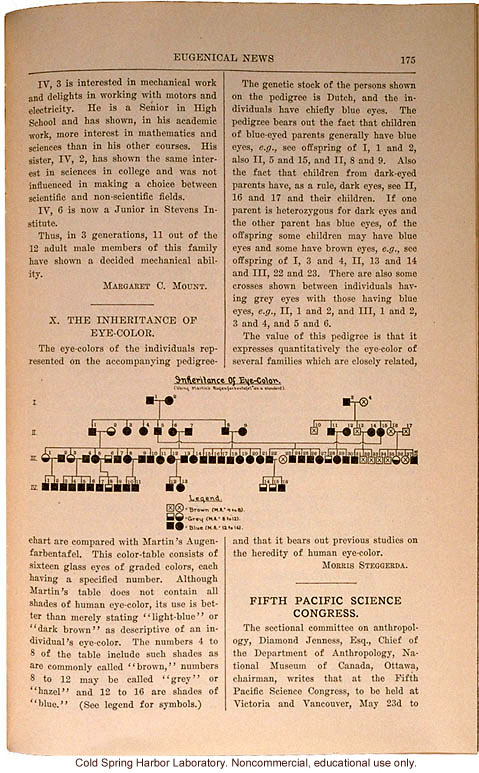Eugenical News 175
[hairline rule across two columns text]
IV, 3 is interested in mechanical work and delights in working with motors and electricity. He is a Senior in High School and has shown, in his academic work, more interest in mathematics and sciences than in his other courses. His sister, IV, 2, has shown the same interest in science in college and was not influenced in making a choice between scientific and non-scientific fields.
IV, 6 is now a Junior in Stevens Institute.
Thus, in 3 generation, 11 out of the 12 adult male members of this family have shown a decided mechanical ability.
Margaret C. Mount.
[centered score]
X. The Inheritance of Eye-Color.
The eye-colors of the individuals represented on the accompanying pedigree-chart are compared with Martin's Augenfarbentafel. This color-table consists of sixteen glass eyes of graded colors, each having a specified number. Although Martin's table does not contain all shades of human eye-color, its use is better than merely stating "light-blue" or "dark brown" as descriptive of an individual's eye-color. The numbers 4 to 8 of the table include such shades as are commonly called "brown,"numbers 8 to 12 may be called "grey" or "hazel" and 12 to 16 are shades of "blue." (See legend for symbols.)
The genetic stock of the persons shown on the table is Dutch, and the individuals have chiefly blue eyes, The pedigree bears out the fact that children of blue-eyed parents generally have blue eyes, [italics]e.g.,[end italics] see offspring of I, 1 and 2, also II, 5 and 15, and II, 8 and 9. Also the fact that children from dark-eyed parents have, as a rule, dark eyes, see II, 16 and 17 and their children. If one parent is heterozygous for dark eyes and the other parent has blue eyes, of the offspring some children may have blue eyes and some have brown eyes, [italics]e.g.,[end italics] see offspring of I, 3 and 4, II, 13 and 14 and III, 22 and 23. There are also some crosses shown between individuals having grey eyes with those having blue eyes, [italics]e.g.,[end italics] II, 1 and 2, and III, 1 and 2, 3 and 4, and 5 and 6.
The value of this pedigree is that it expresses quantitatively the eye-color of several families which are closely related, and that it bears out previous studies on the heredity of human eye-color.
Morris Steggerda.
[centered score]
Fifth Pacific Science Congress.
The sectional committee on anthropology, Diamond Jenness, Esq., Chief of the Department of Anthropology, National Museum of Canada, Ottawa, chairman, writes that at the Fifth Pacific Science Congress, to be held at Victoria and Vancouver, May 23d to
[pedigree chart centered on page, across both columns]
[end]


